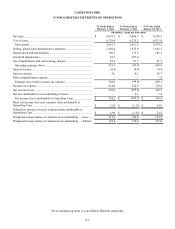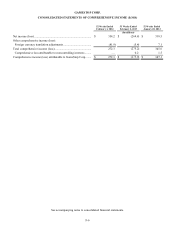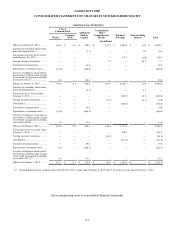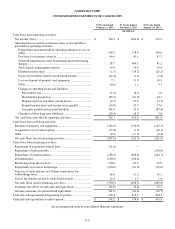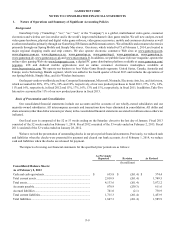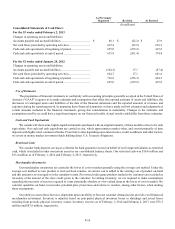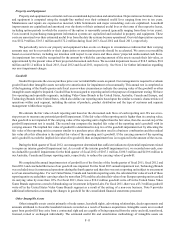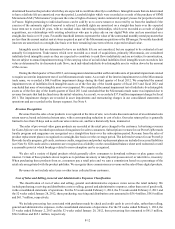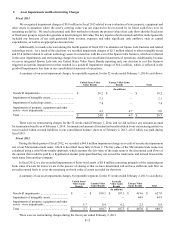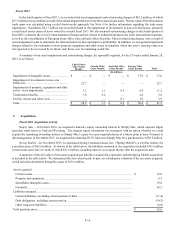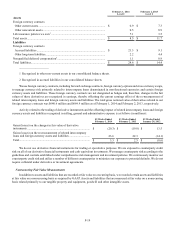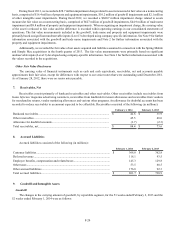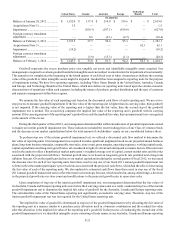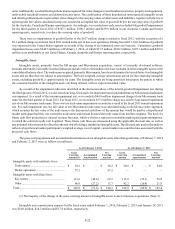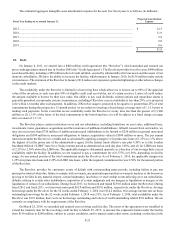GameStop 2013 Annual Report Download - page 86
Download and view the complete annual report
Please find page 86 of the 2013 GameStop annual report below. You can navigate through the pages in the report by either clicking on the pages listed below, or by using the keyword search tool below to find specific information within the annual report.F-13
Customer Liabilities
We establish a liability upon the issuance of merchandise credits and the sale of gift cards. Revenue is subsequently recognized
when the credits and gift cards are redeemed. In addition, breakage is recognized quarterly on unused customer liabilities older
than two years to the extent that our management believes the likelihood of redemption by the customer is remote, based on
historical redemption patterns. Breakage has historically been immaterial. To the extent that future redemption patterns differ from
those historically experienced, there will be variations in the recorded breakage.
Advertising Expenses
We expense advertising costs for newspapers and other media when the advertising takes place. Advertising expenses for
television, newspapers and other media during the 52 weeks ended February 1, 2014, the 53 weeks ended February 2, 2013 and
the 52 weeks ended January 28, 2012 were $57.8 million, $63.9 million and $65.0 million, respectively.
Loyalty Expenses
The PowerUp Rewards loyalty program, introduced in May 2010, allows enrolled members to earn points on purchases that
can be redeemed for rewards that include discounts or merchandise. We estimate the net cost of the rewards that will be issued
and redeemed and record this cost and the associated balance sheet reserve as points are accumulated by loyalty program members.
The two primary estimates utilized to record the balance sheet reserve for loyalty points earned by members are the estimated
redemption rate and the estimated weighted-average cost per point redeemed. Our management uses historical redemption rates
experienced under the loyalty program as a basis to estimate the ultimate redemption rate of points earned. A weighted-average
cost per point redeemed is used to estimate future redemption costs. The weighted-average cost per point redeemed is based on
our most recent actual costs incurred to fulfill points that have been redeemed by our loyalty program members and is adjusted
as appropriate for recent changes in redemption costs, including the mix of rewards redeemed. We continually evaluate our reserve
methodology and assumptions based on developments in redemption patterns, cost per point redeemed and other factors. Changes
in the ultimate redemption rate and weighted-average cost per point redeemed have the effect of either increasing or decreasing
the reserve through the current period provision by an amount estimated to cover the cost of all points previously earned but not
yet redeemed by loyalty program members as of the end of the reporting period.
Historically, the cost was recognized in selling, general and administrative expenses and the associated liability was included
in accrued liabilities. However, in the fourth quarter of 2013, we determined that the net cost of the rewards that will be issued
and redeemed would be better presented as cost of sales. The cost of administering the loyalty program, including program
administration fees, program communications and cost of loyalty cards, will continue to be recognized in selling, general and
administrative expenses. The cost of free or discounted products recognized in cost of sales for the 52 weeks ended February 1,
2014 was $18.2 million. The cost of free or discounted products for the 53 weeks ended February 2, 2013 and the 52 weeks ended
January 28, 2012 was $31.2 million and $37.8 million, respectively, all of which was recorded in selling, general and administrative
expenses as discussed above. The reserve is released when loyalty program members redeem their respective points and the
corresponding rewards are recorded to cost of goods sold in the period of redemption.
Income Taxes
Income tax expense includes federal, state, local and international income taxes. Income taxes are accounted for utilizing
an asset and liability approach and deferred tax assets and liabilities are recognized for the tax consequences of temporary differences
between the financial reporting basis and the tax basis of existing assets and liabilities using enacted tax rates. The effect on
deferred tax assets and liabilities of a change in tax rates is recognized in the period that includes the enactment date. Valuation
allowances are recorded to reduce deferred tax assets to the amount that will more likely than not be realized. In accordance with
GAAP, we maintain liabilities for uncertain tax positions until examination of the tax year is completed by the applicable taxing
authority, available review periods expire or additional facts and circumstances cause us to change our assessment of the appropriate
accrual amount (see Note 13).
We plan on permanently reinvesting our undistributed foreign earnings outside the United States. Where foreign earnings
are permanently reinvested, no provision for federal income or foreign withholding taxes is made. Should we have undistributed
foreign earnings that are not permanently reinvested, United States income tax expense and foreign withholding taxes will be
provided for at the time the earnings are generated.
Lease Accounting
We lease retail stores, warehouse facilities, office space and equipment. These are generally leased under noncancelable
agreements that expire at various dates through 2034 with various renewal options for additional periods. The agreements, which
have been classified as operating leases, generally provide for minimum and, in some cases, percentage rentals and require us to
pay all insurance, taxes and other maintenance costs. Leases with step rent provisions, escalation clauses or other lease concessions




